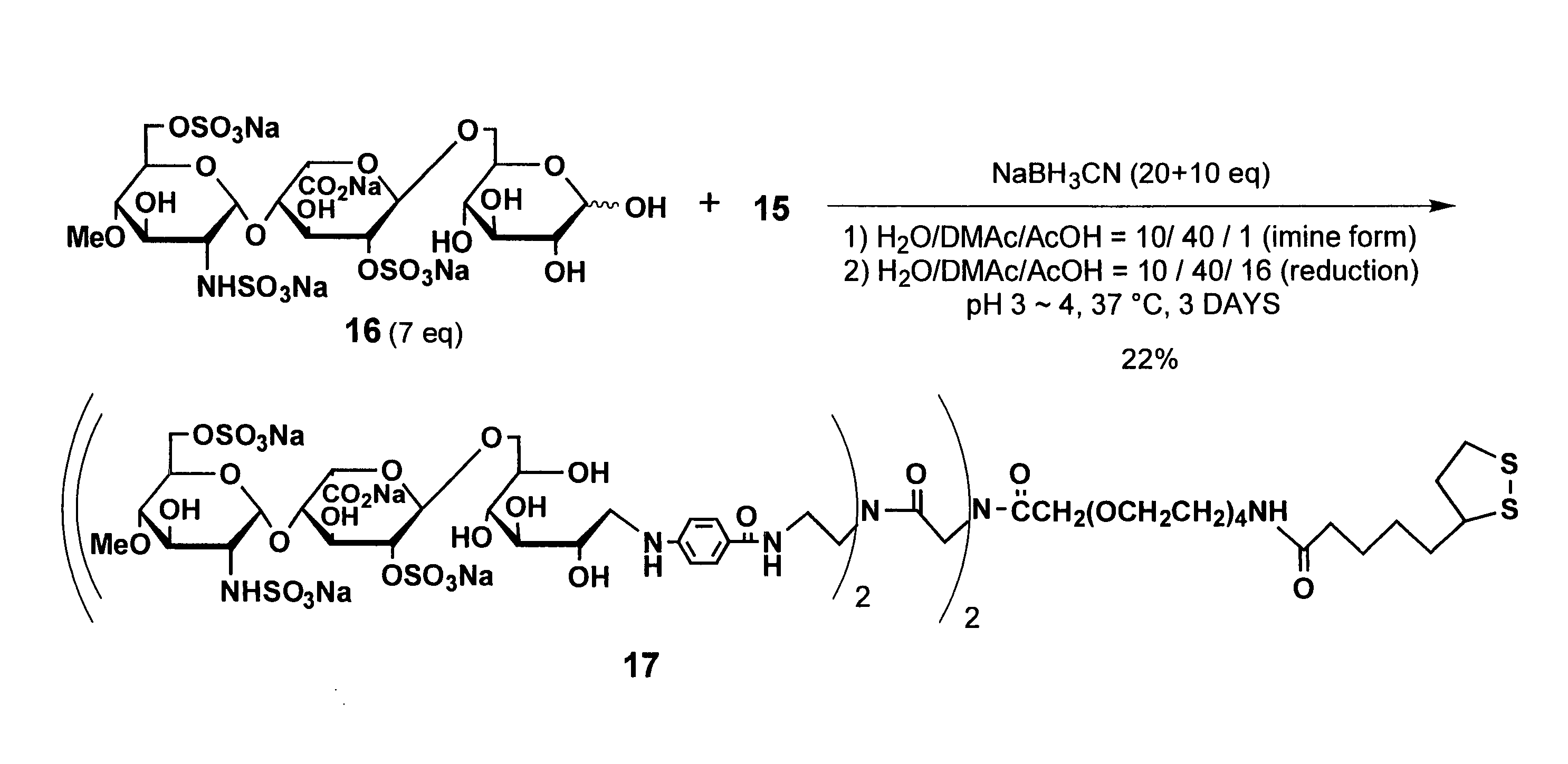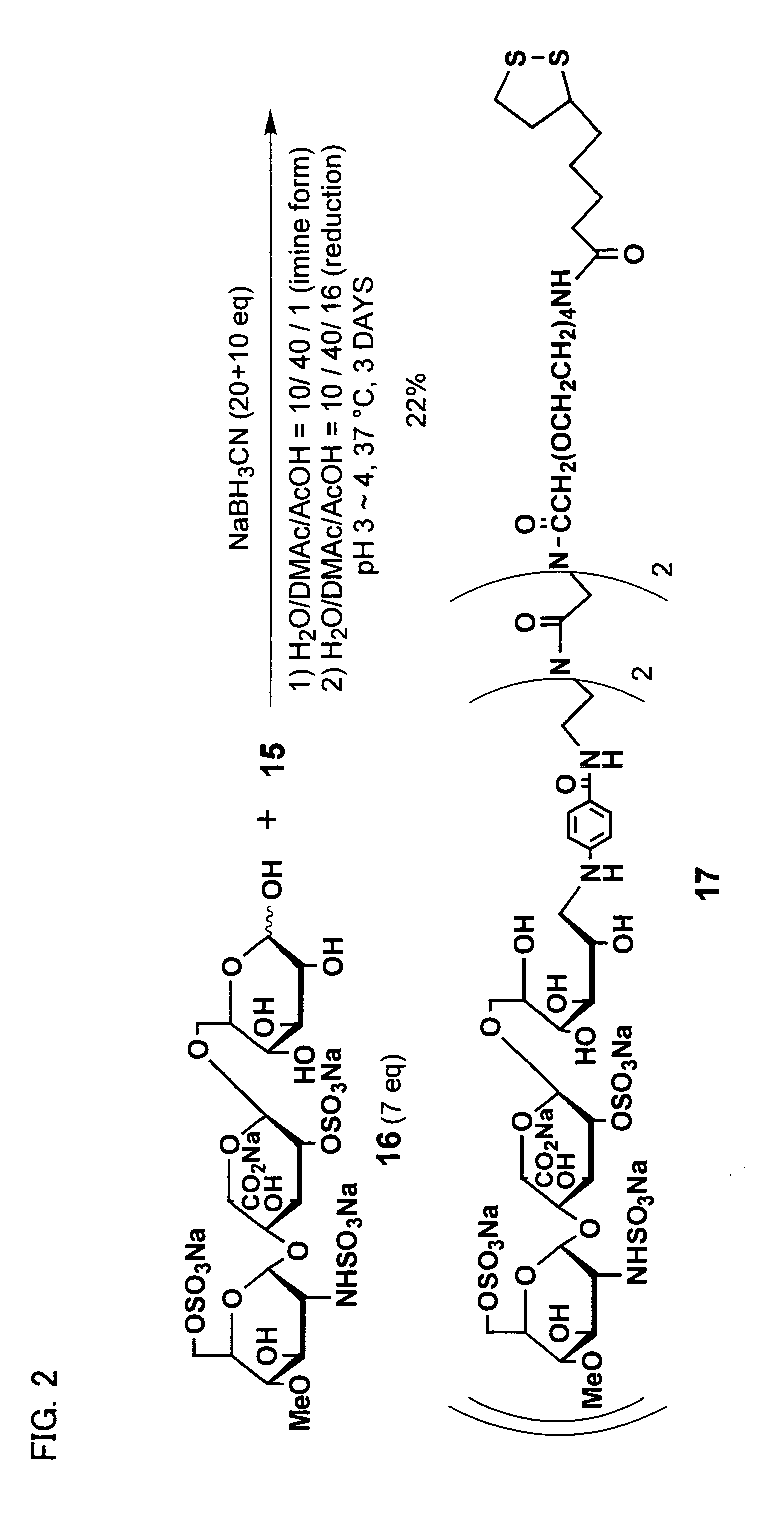Linker Compound, Ligand Conjugate, and Production Methods Thereof
a technology which is applied in the field of linker compound and ligand conjugate, and the production method of the latter, can solve the problem that the linker compound does not effectively make the metal-sulfur bond, and achieve the effect of high reproducibility
- Summary
- Abstract
- Description
- Claims
- Application Information
AI Technical Summary
Benefits of technology
Problems solved by technology
Method used
Image
Examples
example 1
Synthesis of Linker Compound (Compound 15)
[0118] One of linker compounds according to the present invention, i.e. a linker compound (Compound 15) having a structure represented by general formula (2) where n is 4, X is represented by general formula (3), wherein p1 and p2 are l, m1, m2, m3, m4 are 2, was synthesized according to the following procedure. FIG. 1 illustrates a process of synthesizing the linker compound (Compound 15). Note that reference numerals given to compounds in the description of Example 1 correspond to reference numerals shown in FIG. 1.
[0119] As illustrated in FIG. 1, first of all, bis[2-(2-hydroxyethoxy)ethyl]ether (Compound 1) as a raw material was brought into reaction with ethyl diazoacetate (Compound 2) in dichloromethane in the presence of BF3.Et2O to synthesize an ester compound (Compound 3) at the yield of 40%. Then, Compound 3 was brought into reaction with p-toluenesulfonyl chloride in dichloromethane in the presence of DMAP and pyridine to obtain ...
example 2
Synthesis of Ligand Conjugate (Compound 17)
[0163] Using the linker compound 15 obtained in Example 1, a ligand conjugate having an oligosaccharide-derived structure represented by general formula (5) where n is 4, p1 and p2 are l, m1, m2, m3, and m4 are 2, R′ is hydrogen (H), and R is represented by general formula (12) was synthesized according to the following procedure. FIG. 2 illustrates a chemical reaction formula of the synthesis.
[0164] As shown in FIG. 2, reductive amination reaction was performed using the linker compound 15 obtained in Example 1, and the compound 16 (7 equivalents) which is a sugar molecule represented by general formula (12). With this, Compound 17 which is an example of the ligand conjugate of the present invention was obtained at a yield of 22%.
[0165] More specifically, the linker compound 15 (2.0 mg, 1.67 μmol) and Compound 16 (10 mg, 11.7 mmol) were dissolved in a mixture solvent of 100 ml of water, 400 ml of dimethylacetamide, and 10 ml of acetic a...
example 3
Verification of Interaction Between a Sugar Chain Serving as Ligand and a Protein
[0168] In the present Example, using a ligand conjugate obtained in Example 2 and having an oligosaccharide-derived structure represented by general formula (5) where n is 4, p1 and p2 are l, m1, m2, m3, and m4 are 2, R′ is hydrogen (H), and R is represented by general formula (6-3) (This ligand conjugate is hereinafter referred to as “Tetra-GlcNS6S-IdoA2S-Glc”), an intermolecular interaction between Tetra-GlcNS6S-IdoA2S-Glc and a protein was verified.
[0169] In the present Example, for the purpose of comparison, similar experiments were conducted on another two ligand conjugates that the inventors of the present application found before, and comparative study on their interactions was conducted. One of the two ligand conjugates, more specifically, is the ligand conjugate described in Patent document 1 and represented by general formula (13). Hereinafter, this ligand conjugate is referred to as “Mono-G...
PUM
| Property | Measurement | Unit |
|---|---|---|
| temperature | aaaaa | aaaaa |
| wavenumber | aaaaa | aaaaa |
| thick | aaaaa | aaaaa |
Abstract
Description
Claims
Application Information
 Login to View More
Login to View More - R&D
- Intellectual Property
- Life Sciences
- Materials
- Tech Scout
- Unparalleled Data Quality
- Higher Quality Content
- 60% Fewer Hallucinations
Browse by: Latest US Patents, China's latest patents, Technical Efficacy Thesaurus, Application Domain, Technology Topic, Popular Technical Reports.
© 2025 PatSnap. All rights reserved.Legal|Privacy policy|Modern Slavery Act Transparency Statement|Sitemap|About US| Contact US: help@patsnap.com



